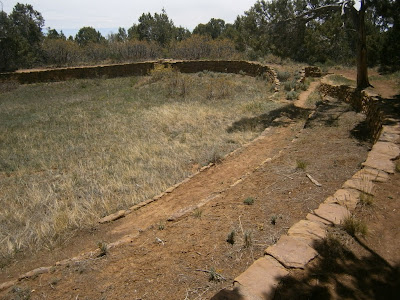The slow leak in my air mattress is getting bigger and my
bones are being lowered to the ground progressively earlier each morning. It is
far more effective than any alarm clock.
On our way to Moab
we stopped at Monticello
visitor centre for an internet and geographic orientation. Nearby there were more pueblo
ruins that had to be checked out, and then we headed into the hills to see :Newspaper
Rock". There is a less circuitous route to it, I learned later, that would have avoided
having to climb up to the snowline, although the view from there was quite stunning.
 |
| Newspaper Rock. Actually, there is a guy sitting behind me with a mass of tattoos that look like this. |
Newspaper Rock is a slap of darkened sandstone that The
Ancients have used as a notice board, message board for the gods, or perhaps
just a graffiti wall. Perhaps it is nothing more than doodles and messages no
more profound than “Hopi is a corn head”. Really smart people have so far been unable
to decode it all. Although I will say
that one character looks for all the world like Bart Simpson.
 |
| Tell me that doesn't look like Bart. |
Moab
is the place for the outdoorsy folks to be and be seen. What an adventure Mecca for the hikers, bikers, kayakers, rock
climbers… you name it. My destination for the day was Arches National Monument,
and this turned out to be quite the adventure.
The rock sculptures are nothing short of spectacular! I belived that Monument Valley would be the place to witness that, but
the landscape here far surpasses anything I have ever seen. Around every corner
was an eye popping sight that required a photo stop. At one of these I met a
couple from France, Philippe and Catherine, who are driving around in a
motorhome they rented from San
Francisco. In spite of our language challenges, we
became fast friends and met again at the trail head for a hike to Delicate Arch.
 |
| Wow!! What else can I say? |
That 5 km hike is now on the top five of the most scenic and
exotic hiking experiences of my life. Petroglyphs were exposed at the beginning
of the trail just to add a cultural element to a magnificent stroll. We walked
up and over sandstone bedrock to an elevation that afforded a view of the valley
and surrounding cliff faces. Again the rock colours were what I would have to
term simply 'unrealistic'. Rocks just don’t come in those flavours. A natural
sidewalk angled us up the face of a rock wall, atop of which was a small arch.
Begging a photo op we scrambled up to it to pose in front, only to see the big
arch directly behind it. Images like that render one speechless.
 |
| That's cool, but look behind you, Boy! |
 |
Campgrounds were full, so it was necessary to be resourceful
once again. We agreed to meet at a particular spot on a dirt access road just before
sunset. My little camp was set up and I beginning to write this blog while the
sun lit up the mini-Ayers Rock behind me and the big full moon hung like a
party balloon over it. Life could not be finer.
 |
| What a beautiful place this might have been to spend the night. |
My friends soon came bouncing along the road to join me, followed
by Mr. Ranger who reckoned something was suspicious about a big RV heading off
into the sunset on a dirt access road. As indeed there was. Anyway, he shut us
down and I was instructed to dismantle my camp and skedaddle. Rats.
But dismantle I did, and with haste as it was getting dark in a hurry. Driving out of the park the
gargoylian rock masses against the moonlit backdrop presented a much different
view than on the way in and I regret that I was in no position to make a photo stop.
Mr. Ranger did give some directions for a road outside the park
alongside of which one can park and camp gratis. In practice, however, those
instructions were inadequate and I have no idea what we has getting at. Even a day later and after conversations with the locals, it made no sense.
Roaring up the highway in the dark, however, and with no clear
destination in mind was unsatisfying. Finally we found a parking lot for a
saloon/restaurant right beside the highway that fit the bill. Philippe and Catherine
invited me to take the overhead bunk in their spacious rig and I was happy to
accept their generous offer.
Over a few beer and exchanges in our fractured English and
French we had a pretty good chat. Coincidently, they live a short distance from the
area in Burgundy
where cousin Betty and friends Lisa and Dorothy and I will be cruising in our
canal boat at the end of June.
Every day is an adventure, eh what!
















































